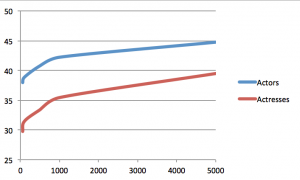Age Difference Between Leading Actors and Actresses
/Much has been made of the age gap between leading men and women. Male romantic leads are often cast opposite much younger females. And it is often difficult for actresses to find roles after age 40. While I suspect this gender gap has improved in the past 50 years, I decided to see if it is still alive and well. I built a spider to scrape age data for the top 5,000 actors and actresses, as ranked by IMDb "starmeter."
For the 500 most popular actors and actresses on IMDb, the average actor is age 40.77 and the average actress is age 33.39. Expanding to the top 5,000 actors and actresses on IMDb, the gap narrows. Here the average actor is 44.74 and the average actress is 39.47.
Not surprisingly, star popularity is correlated to age. The top 50 actors are the youngest, and possess the largest age gap between men and women. For the top 5000 actors, the average age is older, and with a smaller age gap. This chart shows how the age gap narrows as popularity decreases.
Another interesting phenomenon is that 60% of the top 500 most popular stars on IMDb are female. This trend holds true for the top 100 most popular stars, as well as for the top 50. Put another way, only 40% of the 500 most popular stars on IMDb are male.
However, when the sample size is stretched to include the 5,000 most popular stars, women equal men almost exactly (50.59% - 49.41%).
So why are women more likely to have high starmeter ratings? Amazon's starmeter algorithm is a measure of what people are searching for. A glance at the IMDb message boards suggests IMDb's userbase is disproportionately male. So it could very well be that men search for their favorite actresses at a higher rate than women search for their favorite actors. Thus, actresses may have a slight advantage in obtaining top "starmeter" rankings on IMDb.
